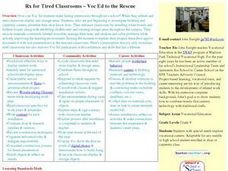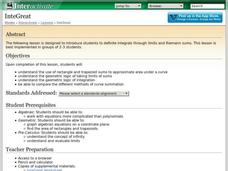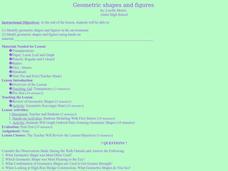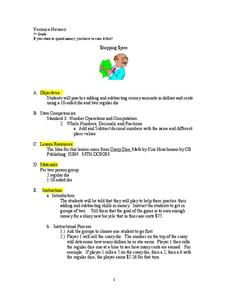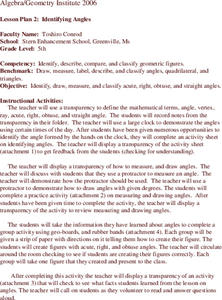Region of Peel
Put Me in Order
Sorting fractions, integers, decimals and square roots into sequential order is an active process when you use a gym as your setting. After your class is divided into two groups and provided with number cards, they compete to see who can...
Illustrative Mathematics
Christo’s Building
Hook your charges on how to solve a real-world art problem with mathematics by showing works of Christo. You can find eye-catching images on the Christo and Jeanne Claude webpage. Here, math learners help Jean Claude and Christo prepare...
Mathed Up!
Circle Theorems
Explore theorems involving circles. Individuals watch a video that reviews the basic parts of a circle. They learn about circle theorems and compete a learning exercise of problems that use these theorems — putting their skills to work...
Curated OER
Rx for Tired Classrooms: Vocational Ed to the Rescue
Secondary carpenters apply their skills to improve display spaces in classrooms at their campus. Includes a contract between workers and teachers who sign on for improvements in the their rooms. Concurrent exploration of building and...
Curated OER
Developing Effective Instructional Plans and Assessments in Mathematics
Students in a teacher education program develop a technology based lesson plan. After the lesson is created, they develop their own performance assessment. They identify the characteristics of good assessment instruments and model best...
Curated OER
First Degree Equations
High schoolers establish a solid competence in solving all types of equations and a solid understanding of how variables and equations can be utilitzed to solve real life problems.
Curated OER
Electromagnetic Pick-up
Students investigate electromagnetic energy. In this magnetism instructional activity, students will create an electromagnet and test changes with increased energy. They will compete by building the strongest electromagnet.
Curated OER
Tic-Tac-Toe
Students investigate finite mathematics using a flow chart. In this algebra activity, students investigate logic and strategies using flowcharts. Students compete against each other using different approaches to playing the game.
Curated OER
What are the Kinds of Triangles?
Fifth graders classify triangles. In this triangle lesson, 5th graders learn about the characteristics that make up a triangle. They are instructed through video, PowerPoint slides, and teacher-led demonstrations.
Shodor Education Foundation
InteGreat
Hands-on investigation of Riemann sums becomes possible without intensive arithmetic gymnastics with this interactive lesson plan. Learners manipulate online graphing tools to develop and test theories about right, left, and...
Curated OER
Get In Line!
Students compare and order fractions and decimals using a number line. They use rules of conversion to determine equivalencies competing problems accurately and plot points on the number line that represent the correct order of the...
Curated OER
Geometric Shapes And Figures
Students compete in a scavenger hunt to find twenty-two different geometric shapes in natural objects around the school. They practice identification of each geometric shape using a handout then form small groups to search the school...
Curated OER
Spider Spider Math Game
In this spider spider math game activity, students follow the instructions to play the math game that requires them to use their multiplication skills.
Curated OER
Shopping Spree
Sixth graders examine currency by completing monetary equations. In this economics lesson, 6th graders participate in a numbers experiment where they roll a die and earn money based on their roll. Students compete for their...
Curated OER
Equivalent Numbers
Students work together matching numbers on index cards. They must match numbers in different forms, such a fractions and percentages. They compete with other groups in the class to get the most correct.
DECA
Sample Exam: Personal Financial Literacy
Looking for a way to assess pupils' personal financial literacy? A 100-question, multiple-choice exam provides a good understanding of what class members already know and need to know about personal finance.
Curated OER
Many Ways to Represent Our Data
Demonstrate several ways to represent data with your class. They will use surveys to gather data and display the data using tally charts and graphs. Then answer questions according to the data.
Curated OER
Number Patterns
Help your learners to identify even and odd numbers. In this number sense lesson, they read the book Madeline and use counters to identify which number has a "partner." Learners write down odd and even numbers on a whiteboard.
Curated OER
Building Understanding of Rate of Change/Slopes Using Alice
Students explore slope as a rate of change. In this eighth grade mathematics activity, students investigate real-world problems to determine rate of change and transform it into a linear representation, thus determining slope. Students...
Curated OER
Hickory Dickory Doc Tell Time
Students discover time keeping by reading clocks. In this time-telling lesson, students read the story Hickory Dickory Dock, and discuss the measurements of time we use. Students complete worksheets in which they identify the...
College Board
Try This! Calculus Teaching Tips
It's important to spice up your lessons. An online article discusses teaching strategies for AP® Calculus. In-class activities include matching games, placemats, multiple choice questions, scripted discussion, involuntary discussion,...
Curated OER
Identifying Angles
Students identify names of angles. They use a large clock to demonstrate angles using certain times of day. Given a geoboard, students create figures with acute, right, and obtuse angles.
Curated OER
Relating Algebra to Geometry
Learners investigate the connection that exists between Algebra and Geometry. They classify two and three-dimensional figures. Pupils use formulas to solve problems in geometry and use appropriate measuring devices in the right contexts.
Curated OER
Shapes from Shapes
Geometric shapes are really cool. Examine triangles, quadrilaterals, trapezoids, rhombuses, parallelograms, pentagons, and hexagons with your class. They draw large shapes and small shapes then compare them to understand their shapely...



